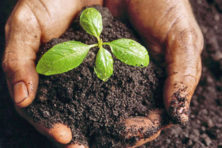Test Your Soil Before Adding Nutrients
- Share
- Tweet
- Pin
- Share
Blind decision-making. Financial expense with unknown return. Potential environmental pollutant. While this sounds extreme, it is exactly what so many of us are doing when we add fertilizer to a vegetable garden, flower bed, lawn or tree without first getting a soil test.
Since soil nutrients obviously aren’t visible, we are left to the logic: I want my plants to grow, fertilizer makes things grow, therefore I should add lots of fertilizer. While in certain situations large additions of fertilizer may be needed, often that is the exception rather than the norm. Getting a soil test allows you to know the baseline nutrient levels in your soil, as well as some other soil characteristics that can change nutrient availability and make it more or less favorable to certain plants.
The University of Wisconsin has a Soil and Forage Analysis Laboratory located in Marshfield, Wisconsin. The UW standard soil test determines the soil pH, percent of organic matter, and the total amount of phosphorus and potassium.
Additional tests are available for secondary and micronutrients (calcium, magnesium, sulfur, boron, manganese, and zinc), and to screen for lead. There are many other private labs throughout the state that perform soil analyses and may offer different tests.
Soil pH: pH is a measurement of the acidity or alkalinity of a substance. In soil, nutrients are often present but tightly bound in soil particles. Soil pH affects some of the chemical and biological processes that take place in the soil and can alter which nutrients are available to plants.
A pH of 7 is neutral, and soils with a pH of less than 7 are more acidic, whereas soils with a pH higher than 7 are more alkaline. Most vegetables and ornamental plants grow best in soils with a pH of 6 to 7, but many plants can tolerate a wider range. There are some plants, however, that require soils that are much more acidic, for example, blueberries, rhododendrons and azaleas.
In many parts of the country, the soil pH is low (acidic), and to make it more favorable for plants, it is recommended to add lime to the soil (the mineral, not the fruit). Much of Door County is characterized by shallow soils over limestone bedrock, so typically the soils in the northern part of the county have a very high pH. Altering pH is not always practical, so knowing the pH of your soil before planting can prevent you from selecting plants that cannot thrive where you place them.
Organic matter: Soil organic matter is the non-mineral components of soil including decayed and degraded plants, animals and microbes (think compost). Essentially, organic matter is the ‘glue’ that holds soil particles together improving the physical condition and characteristics of the soil. Organic matter allows for better drainage in heavy clay soils and better water holding capacity in sandy soils. It also provides many plant nutrients sometimes eliminating the need for any additional fertilizer. Most soils contain 2-4 percent organic matter, and overall the higher the number, the better.
Phosphorus and potassium: The final component of a standard soil test is the total amount of phosphorus and potassium in the soil given in parts per million (ppm). In plants, phosphorus and potassium are considered primary nutrients because plants need them in larger amounts. Phosphorus is important for photosynthesis and encouraging flowering and root formation. Potassium is also needed for photosynthesis and building proteins within the plant. Many soils in Wisconsin already contain plenty of phosphorus and potassium, so it is unnecessary to add more. Additionally phosphorus frequently moves out of the garden and into waterways resulting in algae growth. In Wisconsin it is actually illegal to apply fertilizer to turf that contains phosphorus unless establishing new grass or if the area is deficient based on soil test results (see Wisconsin Statute chapter 94.643).
Nitrogen is another primary nutrient that is involved in almost all plant processes. Nitrogen is difficult to test for, so recommendations are typically based on the garden location and crop being grown.
Now that you are utterly convinced that you need to get your soil tested, the first step is to take a representative sample since your results are only as good as your sampling technique. Using a shovel or soil probe, visit about 10 random locations throughout the garden bed and collect a vertical slice of soil about 5-7 inches deep (a turf sample only needs to be about four inches deep). Combine the samples in a bucket and mix them well. About two cups of the composite soil sample are needed for testing. It is generally recommended to get a new soil test every three years.
If you would like to submit a sample through our office, bring your soil sample to the Extension office (421 Nebraska St., Sturgeon Bay) and we will mail it in. Lawn and garden samples cost $15 per sample plus $2 for shipping.
Once you have received your results, it can be a bit difficult to interpret what they mean. For assistance, contact the Door County Plant Health Advisors, Master Gardener Volunteers available to assist homeowners with horticultural questions. The Plant Health Advisors can be reached by email at [email protected] or by calling 920.746.5984. Another great tool is a garden fertilizer calculator available at door.uwex.edu/horticulture. More information about how to take a soil test is available on that webpage as well.
So save money, protect the environment and make an informed decision by getting your soil tested before planting and before using fertilizer.

